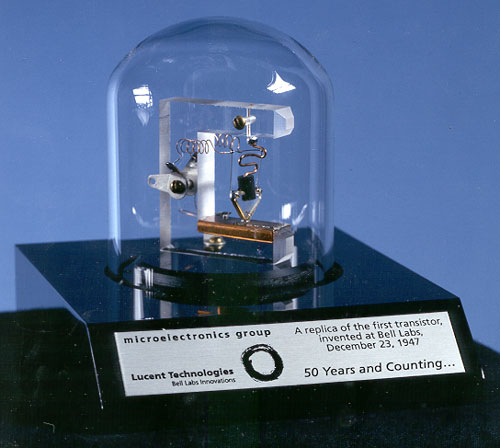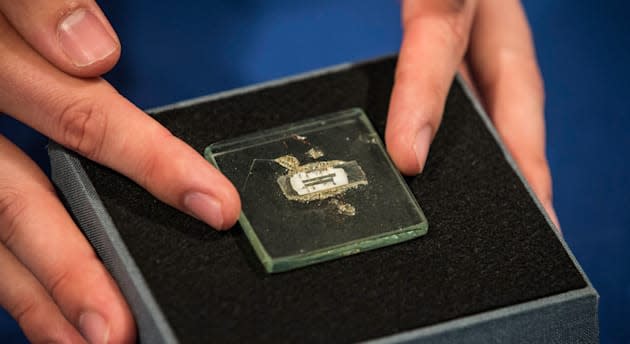5.3.1 From Transistors to Microprocessors
05 Early Arcades and Electricity
A Brief History of Electrical Engineering: From Transistors to Microprocessors
Before the transistor

Before the transistor was invented, vacuum tubes were used to conduct the binary signals that allow for information to be transmitted. The vacuum tubes contained a cathode and an anode separated by an electrically charged grid. The electrons which would typically flow from cathode (+) to anode (-) can be interrupted when the grid is given a negative charge, causing the flow to be blocked, generating a binary signal. The binary signal produced by 18000 vacuum tubes allowed the ENIAC, the first programmable computer to perform its calculations.
Transistors, Resistors, Capacitors
There are many components that make up an electronic circuit.
n 1947, Bell Laboratories unveiled the first fully-operational transistor. The transistor performs almost the same function as the vacuum tube, but at a much smaller scale. It can be thought of as the foundation of modern computers.
"A transistor is a semiconductor device with at least three terminals for connection to an electric circuit. In the common case, the third terminal controls the flow of current between the other two terminals. This can be used for amplification, as in the case of a radio receiver, or for rapid switching, as in the case of digital circuits." – History of the Transistor, Wikipedia
Ever since Bell's unveiling of their working transistor, the minimum possible size of the transistor has continued to shrink. While the transistors for sale at hobby stores are about the size of your finger nail, microscopic transistors are still the foundation of contemporary central processing units (CPUs).


Integrated circuits
"Invented in the late 1950s, integrated circuits – also called microchips – allowed the discrete components that used to form electronic circuits to be shrunk and flattened onto a silicon chip. The result was a massive breakthrough in electronics. Integrated circuits were not only much smaller but were easy to mass produce (the chips could essentially be printed en masse), used less electricity and were more reliable."
Donovan, Tristan. Replay: The History of Video Games. (p.37, Footnote 3)

A 56-year-old prototype of the first microchip going up for auction | Engadget
Above is an image of the first microchip invented.
"A microchip is a set of interconnected electronic components such as transistors and resistors that are etched or imprinted onto a tiny chip of semiconducting material, such as silicon or germanium. Microchips are usually used for the logic component of a computer, known as the microprocessor, or for the computer memory, also known as RAM chips. The microchip can contain a set of interconnected electronic components such as transistors, resistors, and capacitors that are etched or imprinted on a tiny, wafer-thin chip.
An integrated circuit is used as a controller switch to perform a specific task. The transistor in the integrated circuit acts like an on and off switch. The resistor controls the electrical current that moves back and forth between the transistors. The capacitor collects and releases electricity, while a diode stops the flow of electricity." – Source. "Who Invented the First Microchip?". ThoughtCo.
Higinbotham's "Tennis for Two," the original Pong style game, was programmed using transistor to transistor logic. The drop in the price of integrated circuits enabled Harold Lee to make "television games" available for the consumer market, taking the video game from the arcade, into the living room.
Microprocessors
But the implications of the microchip for video games did not end there. As the mid-1970s turned in the late 1970s, the arrival of a new type of microchip – the microprocessor – would reshape not just the video game business but also the very nature of what and how people played.
Donovan, Tristan. Replay: The History of Video Games (p. 37). Yellow Ant. Kindle Edition.
"Microprocessors are a type of integrated circuit that effectively put the functions of a computer on a single silicon chip. Unlike normal integrated circuits, they could be programmed to perform different functions without any need to redesign the circuit design."
Donovan, Tristan. Replay: The History of Video Games. (p.37, Footnote 4)
Here is a link to an interactive page describing the history of Intel's 4004, the first microprocessor.
https://www.youtube.com/watch?v=y0TPWoJGv-ELinks to an external site.

The ceramic C4040 variant
"In 1974, Nutting and fellow MCI engineer Jeff Frederiksen started Dave Nutting Associates to serve as a contractor for new arcade game concepts. The two learned about IntelLinks to an external site.'s new microprocessor chip set and decided to integrate this technology into a pinball machine, convincing Intel to provide them with one of the first development kits for the Intel 4040Links to an external site.. They integrated the microprocessor into a Flicker (1975) pinball machine provided by Bally ManufacturingLinks to an external site.. This scheme was later patented by the duo as the first microprocessor pinball design." – Dave Nutting, Wikipedia

Following the advent of Intel's 8080, the first microprocessor powerful enough to power graphics, Nutting would go on to create the earliest microprocessor-based arcade video games. The first was 1975's Gun Fight. Later, he would develop other famous microprocessor-based arcade games such as Space Invaders.
